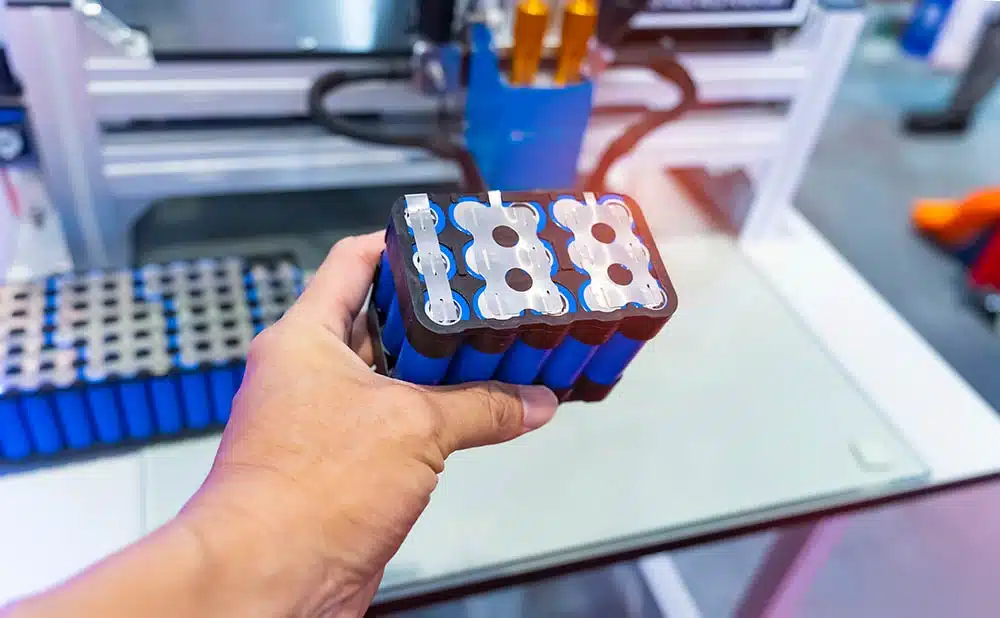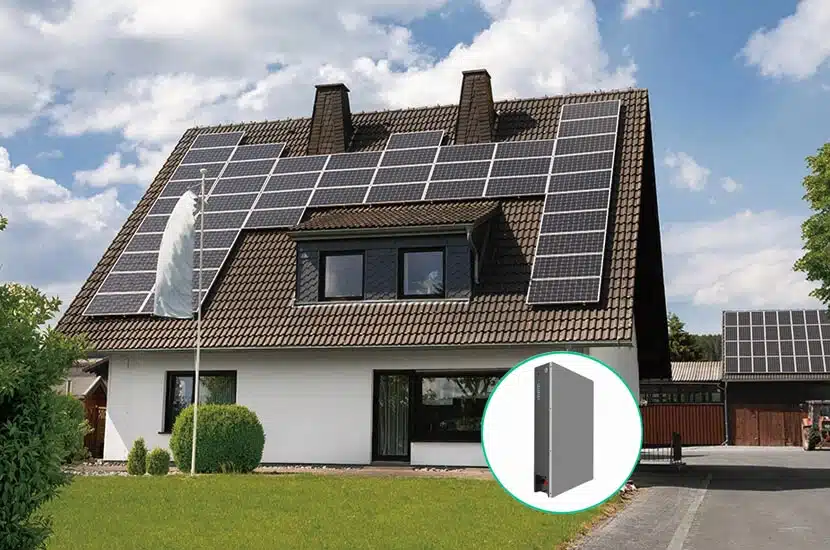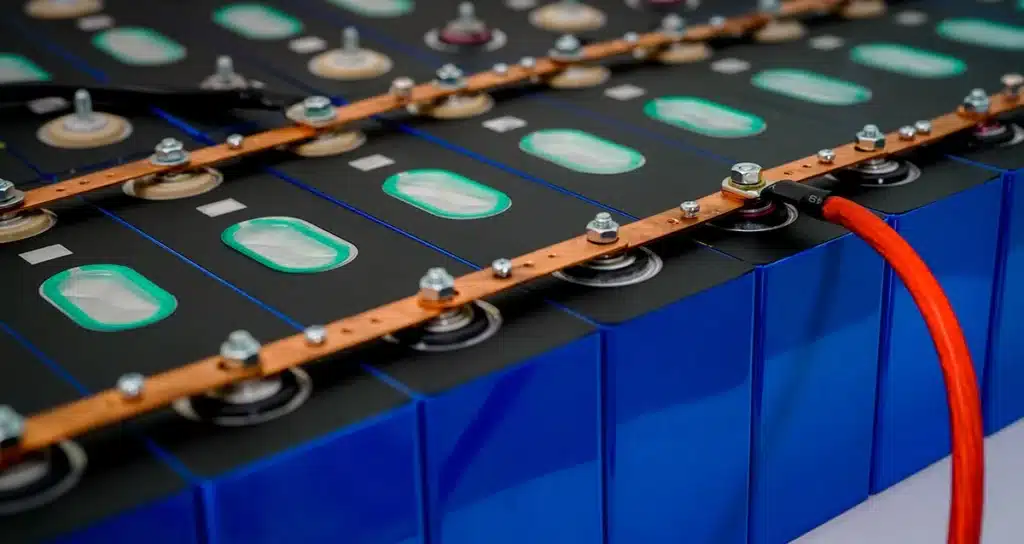Table of Contents
ToggleExternal appearance of lithium batteries
Lithium batteries come in three main shapes: cylindrical, prismatic, and pouch. Each one looks and feels different.
- Cylindrical cells are shaped like a tube. They look similar to AA batteries but are often larger. Common sizes include 18650 and 21700. They are strong and safe because of their metal shell, which holds pressure well.
- Prismatic cells are box-shaped. They have a hard case, usually made of aluminum or steel. These cells save space and are easy to stack, which makes them popular in electric vehicles and energy storage systems.
- Pouch cells are thin, flat, and flexible. They use a soft aluminum-plastic film instead of a hard case. That makes them lighter and more adaptable to custom shapes. These are common in phones, tablets, and wearable devices.
The outer shell of a battery protects the inside parts and helps manage heat. Cylindrical and prismatic batteries use metal shells, usually stainless steel or aluminum. These materials are strong, resist corrosion, and help with heat control. Pouch cells use aluminum-laminated film, which is lighter but still protects the battery from moisture and air.
Color is another visual clue. Some batteries are silver or gray metal. Others are wrapped in blue, green, or black heat-shrink film. This film adds insulation and keeps the battery safe from short circuits. The color itself doesn’t affect how the battery works, but it can help identify the battery type or brand. For example, some factories use specific colors for certain products or customers.
So, by looking at the shape, shell material, and color, you can often tell what kind of lithium battery you’re dealing with — even without opening it up.
Lithium battery shapes explained

Lithium batteries come in different shapes, and each one has its own strengths. The three main types are cylindrical, prismatic, and pouch.
Cylindrical cells are the most common. They look like large AA batteries and are easy to handle and produce. Two popular sizes are 18650 and 21700:
- 18650 means 18mm wide and 65mm long. It’s used in power tools, laptops, and some small EVs.
- 21700 means 21mm wide and 70mm long. It holds more energy than 18650 and is often used in electric vehicles and energy storage.
The main difference between them is size and energy capacity. 21700 is bigger, so it stores more power in one cell.
Prismatic cells are rectangular and have a strong metal case. They save space by stacking easily, like building blocks. You’ll see them in electric cars and home batteries. A well-known example is the LiFePO4 prismatic cell, like the BYD blade battery. This type is stable, safe, and lasts a long time.
Pouch cells are flat and sealed in a soft aluminum-plastic film. They can bend slightly and fit into tight spaces. These are often found in smartphones, tablets, drones, and medical devices. The best part? There’s no fixed shape. At Hongyitai, we can produce custom pouch cells from 25mAh to 4000mAh, with different lengths, widths, and thicknesses. This makes pouch cells great for OEM projects that need a specific size.
- Cylindrical = strong and easy to use
- Prismatic = space-saving and stackable
- Pouch = flexible in size and lightweight
Size variations by application

Tiny cells are used in small devices like smartwatches, hearing aids, and TWS (true wireless stereo) earbuds. In a typical set of earbuds:
- Each earbud uses a 25mAh to 50mAh battery
- The charging case holds a 400mAh to 700mAh battery
These cells are small, light, and shaped to fit the compact space inside each part.
Medium-sized cells are found in phones, tablets, cameras, and power banks. These batteries usually hold between 1000mAh and 5000mAh. They’re designed to provide more energy over a longer time. Most pouch and prismatic types are used here, where space is still limited, but more power is needed than wearables.
Large format cells are built for high-energy systems. This includes electric vehicles (EVs) and home energy storage units. EV battery packs are made from many large cells, often in prismatic or pouch form. For homes, lithium batteries can power off-grid systems from 5kWh to 20kWh. These are used to store solar energy and provide backup power.
In short, the smaller the device, the smaller the cell — but as energy needs grow, so does battery size. Each size is made to match the job it needs to do.
Battery labels and markings
If you look closely at a lithium battery, you’ll find useful information printed right on it. These markings help you understand what kind of battery it is, how much power it holds, and whether it meets safety standards.
Most lithium batteries show a model number, a voltage, and a capacity rating. For example, you might see something like “LP803048 3.7V 1000mAh.” Here’s what that means:
- LP803048 is the model number. It often tells the battery’s shape and size (in this case, 8.0mm thick, 30mm wide, 48mm long).
- 3.7V is the voltage, which tells you how much electric pressure the battery delivers.
- 1000mAh means the battery can deliver 1000 milliamp-hours of current — a way to measure how long it lasts.
Besides these numbers, you might also see certification marks. These are signs that the battery has passed certain safety or transport tests. Common marks include:
- CE (Europe safety standard)
- UN38.3 (required for shipping lithium batteries)
- RoHS, MSDS, or IEC62133 (used for specific countries or products)
At Hongyitai, all of our lithium batteries come with the certificates needed for smooth customs clearance and safe delivery. Whether you’re importing to the U.S., Europe, or Asia, these labels help your battery enter the market legally and safely.
Knowing how to read a label helps you match the right battery to your product — and avoid using the wrong type by mistake.
What’s inside the case

The outside of a lithium battery tells you a lot — but what’s inside matters just as much. Inside every lithium battery are three key parts: the anode, cathode, and separator.
The anode is the negative side, usually made of graphite. The cathode is the positive side and is made from a lithium-based material, like lithium cobalt oxide or lithium iron phosphate. Between them is the separator, a thin layer that keeps the two sides apart while still allowing lithium ions to pass through. This setup is what allows the battery to charge and discharge safely.
The internal structure changes depending on the battery type:
- Cylindrical cells have layers of anode, cathode, and separator rolled into a spiral (like a jelly roll).
- Prismatic cells stack flat sheets of these materials inside a metal case.
- Pouch cells also use stacked layers, but seal them in a soft foil pouch, which saves space and weight.
Why does the inside matter so much? Because the design affects performance, safety, and lifespan. For example, good separator materials reduce the risk of short circuits. A strong cathode material can increase energy capacity. And the way the layers are arranged helps manage heat during charging or heavy use.
In short, what’s inside your battery helps decide how long it lasts, how safely it works, and how well it performs in your device. A good-looking battery still needs good parts inside.
Connector and terminal types
Here are some common connector types you might see:
- JST: Small and simple. Often used in toys, LED strips, and small electronics.
- Molex: Similar to JST but more secure. Used in consumer electronics and medical devices.
- XT60: Strong and made for high current. Common in drones and RC cars.
- Anderson: Used for power tools and larger systems.
- Deans (T-plug): Known for fast connections in hobby applications like RC racing.
Now let’s look at the terminals, which are the contact points of the battery:
- Tabs are thin metal strips. Common in pouch cells.
- Button terminals look like the end of a AA battery. You’ll find them in cylindrical cells.
- Bolt terminals use screws for strong contact. Seen in big batteries for solar or EV systems.
- Wire leads are simple wires connected to the battery, ready for soldering or plugging in.
Each connector or terminal is designed to match the battery’s job. A tiny drone doesn’t need the same connection as a solar battery — and getting it wrong can cause problems.
Battery packs vs single cells
So how do you know it’s a pack made of multiple cells? One clue is the number of wires or connectors coming out. Another is the size — if it’s too big for one cell, it’s likely a pack. Inside, the cells are connected in series, parallel, or both.
- Series connection adds the voltage. For example, three 3.7V cells in series = 11.1V.
- Parallel connection adds the capacity. For example, three 1000mAh cells in parallel = 3000mAh.
Some packs combine both to reach higher voltage and higher capacity at the same time.
Many packs also include a BMS, or Battery Management System. This is a small circuit board you can often see on the pack. It protects the battery by:
- Preventing overcharge and over-discharge
- Balancing the charge between cells
- Cutting off power if something goes wrong
A good BMS keeps the battery working safely and smoothly, especially in bigger systems like power banks, scooters, or solar batteries.
Visual clues to battery health
You don’t always need special tools to spot a bad battery. Sometimes, a quick look can tell you something’s wrong. Here are a few signs to watch for.
Custom lithium batteries

Not all batteries are off-the-shelf. Many products need custom lithium batteries made to fit a unique shape, size, or function. These batteries don’t always look like standard ones. They might be long and thin, curved, square, or shaped to fit tight spaces.
Pouch cells are often used for custom work because they’re flexible in size. At Hongyitai, we make lithium polymer cells from 25mAh to 4000mAh, tailored to your exact needs. This is helpful for devices like smartwatches, handheld scanners, and compact medical tools.
For OEM (Original Equipment Manufacturer) projects, batteries are designed to fit into the product smoothly. That includes matching the device’s shape, connector type, and voltage. The battery might be wrapped in a specific color, labeled with your brand, or shaped to fill unused space.
Custom batteries look different — because they’re made to fit, not just function.
Visual differences between battery chemistries
At first glance, it’s hard to tell different lithium battery chemistries apart. But if you look closely, there are a few clues.
Li-ion (lithium-ion) and LiFePO₄ (lithium iron phosphate) cells can look similar, especially in prismatic or cylindrical form. However, LiFePO₄ cells are often larger and heavier for the same capacity. They may also be labeled clearly, especially in battery packs. Want to know more? Visit our full guide here:
Pouch, polymer, and solid-state batteries can also look different:
- Pouch cells have a soft foil casing and may feel flexible.
- Lithium polymer batteries are often pouch type but offer tighter packing and custom sizes.
- Solid-state batteries are still new and often smaller, with a solid internal structure and a more rigid appearance.
While chemistry affects performance, some visual hints can help tell them apart.
Photos and diagrams that help identify batteries
The role of appearance in safety
Conclusion
FAQs
The 18650 cylindrical cell is one of the most common lithium-ion batteries, used in laptops, power tools, and electric vehicles.
